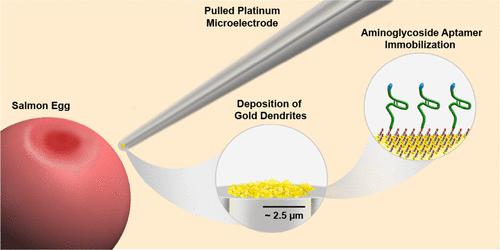Our official English website, www.x-mol.net, welcomes your
feedback! (Note: you will need to create a separate account there.)
Real-Time Intracellular Analysis of Kanamycin Using Microaptasensors
ACS Sensors ( IF 8.2 ) Pub Date : 2023-02-28 , DOI: 10.1021/acssensors.2c02427 Vanshika Gupta 1 , Jeffrey E Dick 1, 2
ACS Sensors ( IF 8.2 ) Pub Date : 2023-02-28 , DOI: 10.1021/acssensors.2c02427 Vanshika Gupta 1 , Jeffrey E Dick 1, 2
Affiliation

|
With the emergence of multidrug-resistant bacteria, infection-related death toll is on the rise. Overuse of antibiotics and their leakage into waterways have transformed the environment into a sink, resulting in bacterial resistance permeating through all tiers of the food cycle. As one of the primary sources of food, fish and fish products such as fish eggs must be studied for their ability to accumulate relevant antibiotics. While the accumulation of these pharmaceuticals has previously been studied, there remains a need to analyze these processes in real time. Electrochemical aptamer-based sensor technology allows for selective, real-time monitoring of small molecules. Herein, we report the first use of miniaturized electrochemical aptamer-based sensors for the analysis of the passive uptake of the aminoglycoside antibiotic, kanamycin, in single salmon eggs. We use pulled platinum microelectrodes and increase the surface area at the electrode tip through dendritic gold deposition. These electrodes showed a 100-fold increase in DNA immobilization on the electrode surface as compared to bare microelectrodes. Additionally, the sensors showed improved stability in complex biological media over an extended period of time when compared to the more widely used macrosensors (r = 1 mm). The sensor range was determined to extend from nanomolar to micromolar concentrations of kanamycin in fish egg lysate and when used in a single salmon egg the μ-aptasensors were able to monitor the passive uptake of kanamycin over time. The accumulation kinetics were simulated using COMSOL Multiphysics software. This research presents the first reported record of passive uptake of a small molecule in a single cell in real-time using electrochemistry.
中文翻译:

使用微适传感器实时细胞内分析卡那霉素
随着多重耐药细菌的出现,感染相关的死亡人数正在上升。抗生素的过度使用及其渗入水道已将环境变成了一个水槽,导致细菌耐药性渗透到食物循环的各个层面。作为食物的主要来源之一,必须研究鱼和鱼卵等鱼制品积累相关抗生素的能力。虽然之前已经研究了这些药物的积累,但仍然需要实时分析这些过程。基于电化学适体的传感器技术可以选择性地实时监测小分子。在此,我们报告了首次使用基于微型电化学适体的传感器来分析单个鲑鱼卵中氨基糖苷类抗生素卡那霉素的被动摄取。我们使用拉铂微电极,并通过树枝状金沉积增加电极尖端的表面积。与裸微电极相比,这些电极在电极表面上的 DNA 固定增加了 100 倍。此外,与更广泛使用的宏观传感器( r = 1 mm)相比,这些传感器在复杂生物介质中在较长时间内表现出更高的稳定性。传感器范围被确定为从鱼卵裂解物中的纳摩尔浓度扩展到微摩尔浓度,并且当用于单个鲑鱼卵时,μ适体传感器能够监测卡那霉素随时间的被动吸收。使用 COMSOL Multiphysics 软件模拟累积动力学。这项研究首次报道了利用电化学在单个细胞中实时被动摄取小分子的记录。
更新日期:2023-02-28
中文翻译:

使用微适传感器实时细胞内分析卡那霉素
随着多重耐药细菌的出现,感染相关的死亡人数正在上升。抗生素的过度使用及其渗入水道已将环境变成了一个水槽,导致细菌耐药性渗透到食物循环的各个层面。作为食物的主要来源之一,必须研究鱼和鱼卵等鱼制品积累相关抗生素的能力。虽然之前已经研究了这些药物的积累,但仍然需要实时分析这些过程。基于电化学适体的传感器技术可以选择性地实时监测小分子。在此,我们报告了首次使用基于微型电化学适体的传感器来分析单个鲑鱼卵中氨基糖苷类抗生素卡那霉素的被动摄取。我们使用拉铂微电极,并通过树枝状金沉积增加电极尖端的表面积。与裸微电极相比,这些电极在电极表面上的 DNA 固定增加了 100 倍。此外,与更广泛使用的宏观传感器( r = 1 mm)相比,这些传感器在复杂生物介质中在较长时间内表现出更高的稳定性。传感器范围被确定为从鱼卵裂解物中的纳摩尔浓度扩展到微摩尔浓度,并且当用于单个鲑鱼卵时,μ适体传感器能够监测卡那霉素随时间的被动吸收。使用 COMSOL Multiphysics 软件模拟累积动力学。这项研究首次报道了利用电化学在单个细胞中实时被动摄取小分子的记录。











































 京公网安备 11010802027423号
京公网安备 11010802027423号